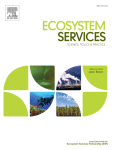Ver ítem
- xmlui.general.dspace_homeCentros Regionales y EEAsCentro Regional Salta - JujuyEEA SaltaArtículos científicosxmlui.ArtifactBrowser.ItemViewer.trail
- Inicio
- Centros Regionales y EEAs
- Centro Regional Salta - Jujuy
- EEA Salta
- Artículos científicos
- Ver ítem
Adding the temporal dimension to spatial patterns of payment for ecosystem services enrollment
Resumen
Payments for Ecosystem Services (PES) programs are increasingly emphasized to address challenges of conserving forests. However, concerns remain regarding the ability of PES programs to ensure long-term conservation of threatened lands. Evaluation of large-scale PES programs, including the spatial and temporal patterns of enrollment, is scarce, especially for programs that aim to protect forest from severe threats such as expansion of industrial
[ver mas...]
Payments for Ecosystem Services (PES) programs are increasingly emphasized to address challenges of conserving forests. However, concerns remain regarding the ability of PES programs to ensure long-term conservation of threatened lands. Evaluation of large-scale PES programs, including the spatial and temporal patterns of enrollment, is scarce, especially for programs that aim to protect forest from severe threats such as expansion of industrial agriculture. Using information on PES enrollment across 252,319 km2 in the Argentine Chaco, we examined both the duration for which lands are enrolled in PES and their suitability for agriculture. Specifically, we examined whether the PES program has resulted in adverse selection not only in space but also in time. We built spatially explicit generalized linear models using information on participants’ length of contract and the potential of their land for agricultural use. We found the PES program enrolled land in areas with high agricultural potential, but enrollment of these lands occurred for shorter time periods than lands with lower levels of threat from deforestation. Consequently, adverse selection occurred over time but not in space. Our work demonstrates the importance of evaluating both temporal and spatial dimensions of adverse selection in PES for informing policy.
[Cerrar]

Autor
Núñez Regueiro, Mauricio M.;
Fletcher, Robert J. (Junior);
Pienaar, Elizabeth F.;
Branch, Lyn C.;
Volante, Jose Norberto;
Rifai, Sami;
Fuente
Ecosystem services 36 : 100906. (April 2019)
Fecha
2019-04
Editorial
Elsevier
ISSN
2212-0416
Formato
pdf
Tipo de documento
artículo
Palabras Claves
Derechos de acceso
Restringido
 Excepto donde se diga explicitamente, este item se publica bajo la siguiente descripción: Creative Commons Attribution-NonCommercial-ShareAlike 2.5 Unported (CC BY-NC-SA 2.5)
Excepto donde se diga explicitamente, este item se publica bajo la siguiente descripción: Creative Commons Attribution-NonCommercial-ShareAlike 2.5 Unported (CC BY-NC-SA 2.5)

